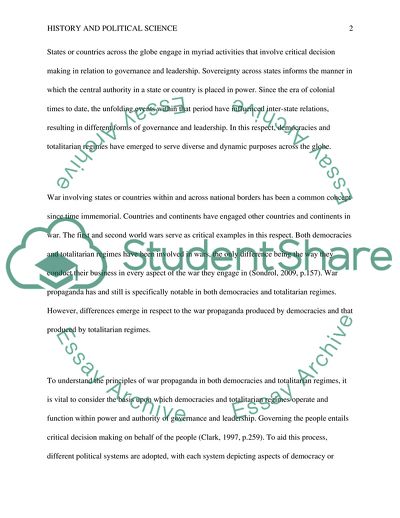Cite this document
(War Propaganda Produced by Democracies and Totalitarian Regimes Essay Example | Topics and Well Written Essays - 2000 words, n.d.)
War Propaganda Produced by Democracies and Totalitarian Regimes Essay Example | Topics and Well Written Essays - 2000 words. https://studentshare.org/politics/1780179-is-there-a-difference-between-the-war-propaganda-produced-by-the-democracies-and-that-produced-by-totalitarian-regimes-and-if-so-what-is-it
War Propaganda Produced by Democracies and Totalitarian Regimes Essay Example | Topics and Well Written Essays - 2000 words. https://studentshare.org/politics/1780179-is-there-a-difference-between-the-war-propaganda-produced-by-the-democracies-and-that-produced-by-totalitarian-regimes-and-if-so-what-is-it
(War Propaganda Produced by Democracies and Totalitarian Regimes Essay Example | Topics and Well Written Essays - 2000 Words)
War Propaganda Produced by Democracies and Totalitarian Regimes Essay Example | Topics and Well Written Essays - 2000 Words. https://studentshare.org/politics/1780179-is-there-a-difference-between-the-war-propaganda-produced-by-the-democracies-and-that-produced-by-totalitarian-regimes-and-if-so-what-is-it.
War Propaganda Produced by Democracies and Totalitarian Regimes Essay Example | Topics and Well Written Essays - 2000 Words. https://studentshare.org/politics/1780179-is-there-a-difference-between-the-war-propaganda-produced-by-the-democracies-and-that-produced-by-totalitarian-regimes-and-if-so-what-is-it.
“War Propaganda Produced by Democracies and Totalitarian Regimes Essay Example | Topics and Well Written Essays - 2000 Words”. https://studentshare.org/politics/1780179-is-there-a-difference-between-the-war-propaganda-produced-by-the-democracies-and-that-produced-by-totalitarian-regimes-and-if-so-what-is-it.


